6/30/2025
Quality Over Quantity
Chris Beytes, Bill Calkins & Jennifer Zurko
While we’re traveling the California Spring Trials, we always get questions by other attendees about what we’ve seen that we like or remember or we think will change the industry. For some reason, it’s hard when you’re in the heat of battle to remember what you saw over yesterday or the day before, let alone that morning, so our answers go like, “Jen, what was the name of that dahlia at Dümmen? The big bicolor, that was nice.” Or “There was a new series of something at Syngenta … was it pentas? No, that was Benary. What was it at Syngenta? Oh, yeah, scaevola!”
Not exactly a ringing endorsement of any variety—but our daily Acres of buZZ! e-news coverage written each evening is actually pretty good because the variety details were fresh in our minds.
Now, if we want a refresher on something we saw at CAST, we do what you do: Watch the videos! We produced 23 of them, ranging in time from a minute and a half to as long as 17 minutes. All show you as much as possible of what we were shown, with as much detail as we were given.
They’re in spectacular 4K technicolor, so you can watch them on your HD big screen and really get an eyeful! And we tried to make them informative AND fun, so expect a bit of goofiness from the hosts, creatively edited by Osvaldo Cuevas.
Find our full YouTube playlist at youtube.com/growertalks. And listen to our post-CAST podcast through Tech On Demand on Apple, Spotify or wherever you listen to your podcasts.
Beyond that, here are some general notes about CAST:
Attendance was down. Maybe to 800 or so … ? From a high of 1,200 or 1,300 … ? That’s in part because Home Depot does its own event and many or most of those growers no longer attend. And travel costs have gone up, so companies are probably sending fewer staffers. But we saw busloads of distribution company sales reps—a top target of breeders. Still, has there been discussion this summer about maybe going to a central location or every other year or whatever? Of course! There always is. And then nothing changes. Maybe a big player or two will decide to drop out and do something different, as Proven Winners did some years back. But we bet a core group will still exhibit in California.
Fewer international visitors. That certainly impacted the numbers. According to one trial host, CAST attendees used to be 60% U.S./40% other countries; now it’s more like 90%/10%. That’s due, in part, to the growth of Flower Trials in Europe in Week 24. And travel costs, too, probably.
More quality time. A side benefit to fewer attendees, and fewer trial stops, is that we’d heard folks were taking a bit more time to slow down and get the most from each stop. Instead of rushing through the stops, giving trial hosts 30 minutes to tell their whole story, folks are lingering, seeing more and getting quality face time with breeders and fellow travelers. It’s half the reason one attends! Admittedly, this can be a challenge for us editors with our unforgiving travel-and-reporting schedule, but we try to slow down to smell—and talk about—the roses ourselves. After all, it’s how we learn what’s happening in the real world of greenhouses, nurseries, flower farms and garden centers.
Memorable Intros
Wave Petunias Celebrates 30 Years
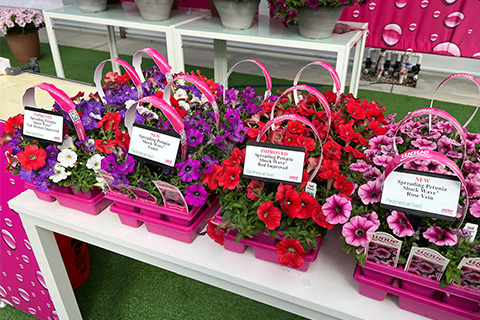
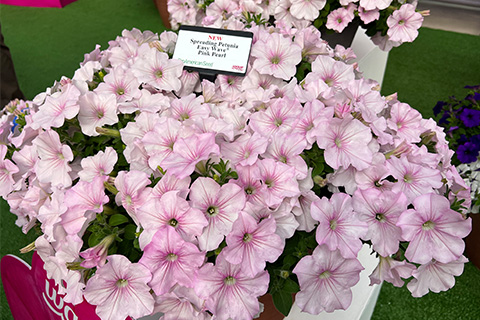 Wave Petunias took up a big chunk of real estate in PanAmerican Seed’s greenhouse in Santa Paula because 2025 is Wave’s 30th anniversary! It was way back in 1995 when they launched the now-famous Purple Wave, bred by Japanese brewery Kirin, but introduced (and now owned) by PanAmerican. The line has grown exponentially since then to include Easy Wave, Tidal Wave, Shock Wave and E3.
Wave Petunias took up a big chunk of real estate in PanAmerican Seed’s greenhouse in Santa Paula because 2025 is Wave’s 30th anniversary! It was way back in 1995 when they launched the now-famous Purple Wave, bred by Japanese brewery Kirin, but introduced (and now owned) by PanAmerican. The line has grown exponentially since then to include Easy Wave, Tidal Wave, Shock Wave and E3.
New to the collection this year is Easy Wave Pink Pearl, which has pretty, pale pink flowers with a hint of rose in the throat and rose veins. (Pearl happens to be the 30th wedding anniversary gemstone).
Shock Wave, the smaller-flowered member of the Wave family, gets two additions—Rose Vein and Violet—and two improvements—Red Improved and Deep Purple Improved, both now having better tolerances for cold-growing.
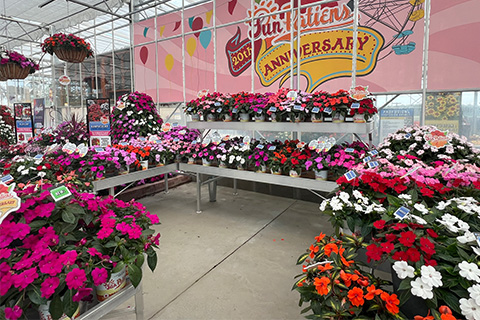
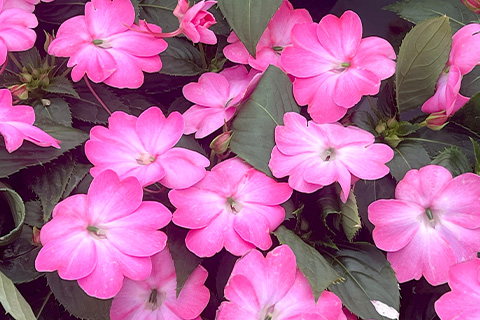 Happy 20th to SunPatiens!
Happy 20th to SunPatiens!
Sakata’s No. 1 annual, SunPatiens, turns 20 this year. It was way back in 2005 when SunPatiens was shown to the public at the Cannes Film Festival, after eight years of breeding, starting with germplasm that originated in Indonesia! It was launched to the industry in 2006.
Twenty years is a long run, but Sakata isn’t resting on its laurels, offering a fantastic new color in the compact assortment, as well as an improvement. Pink Flash (pictured) continues the trend we’ve been seeing in soft pink blooms—and it’s a bicolor, to boot. The improvement for 2026 is Royal Magenta, which disappeared for a couple of years due to some issues with the parent lines, but is back and better than ever.
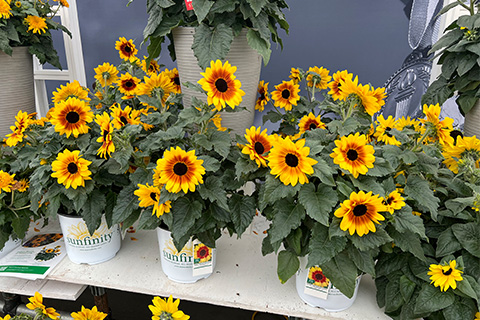 Sunflower Sunfinity Yellow Red Bicolor (Syngenta)
Sunflower Sunfinity Yellow Red Bicolor (Syngenta)
The original Sunfinity was a seed variety (Yellow Dark Center), and last year we saw the first vegetative intro, Sunfinity Double. New for 2026, Syngenta is going back to seed with Sunfinity Yellow Red Bicolor. Its dark central disc is surrounded by a reddish halo graduating to yellow petal tips, making this a perfect crop to produce for fall sales. We think what growers will like most (besides the color) is that Syngenta worked diligently to nail down crop culture for the original seed-raised Sunfinity and this new one can be produced following the same protocols.
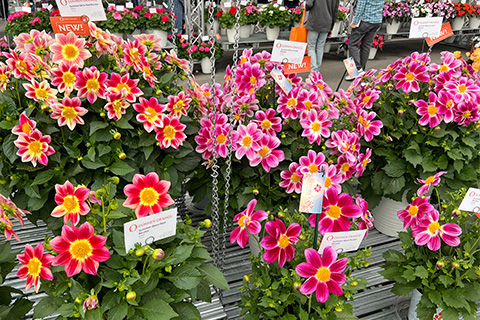 Dahlia Summer Bees Series (Dümmen Orange)
Dahlia Summer Bees Series (Dümmen Orange)
Just inside Dümmen’s door we were stopped in our tracks (seriously—watch the video on our YouTube playlist) by two new dahlias launched for 2026 and no doubt kicking off a new series called Summer Bees. Red and Purple are the first colors and understate the MASSIVE bicolor blooms. They were impressive in large patio pots, but can be produced in gallons for wholesale. You’ve got to check these out! The huge blooms also attract plenty of pollinators.
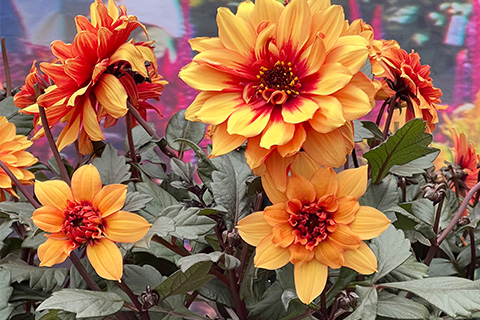 Dahlia Labella Grande Chocolate Series (Beekenkamp)
Dahlia Labella Grande Chocolate Series (Beekenkamp)
Two years ago, we saw the vast assortment of Beekenkamp dahlias displayed series by series and habit by habit. That presentation really helped us understand the positioning of their various dahlias, so when we spotted a Labella Grande sign this year, we already knew they’d be for 6-in. pots and finish quick (14 weeks) from URCs. But what was new and unexpected was the deep, dark foliage that’s the mark of the Labella Grande Chocolate subseries. The foliage contrasts nicely with the double flowers in Rose, Red, Apricot and Amber (pictured). Tech Tip: High light triggers the darkening of the foliage.
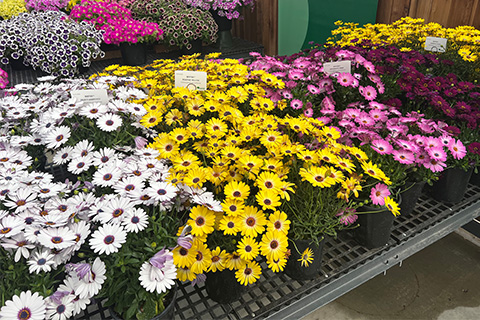 Osteospermum Besties Series (Danziger)
Osteospermum Besties Series (Danziger)
We noticed some renewed breeding activity in osteospermum this year, and Danziger has a whole new series they call Besties, which they say is an upgrade of their older Ostica series (which it will probably replace). Besties improves upon the uniformity of timing and habit of the older series, making it easier to bench-run the seven-color series. Bred in Israel, Besties is said to have good warm-weather performance, too.
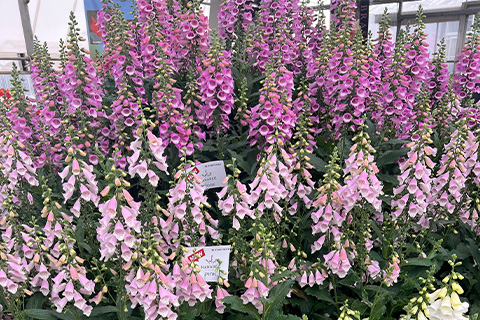 Digitalis Hanabee Series (Takii)
Digitalis Hanabee Series (Takii)
The biggest display at Takii was a huge tower of flowers—the new digitalis series Hanabee—which our tour guide Yusuke Suzuki translated from Japanese as “fireworks.” This new series of three colors is at least a week earlier than the existing Panther series and includes Rose, Pink and White. Yusuke explained that they’re first-year flowering, but should be grown as an annual. We think they’d make awesome patio cut flowers and are excited to see how our plant samples perform.
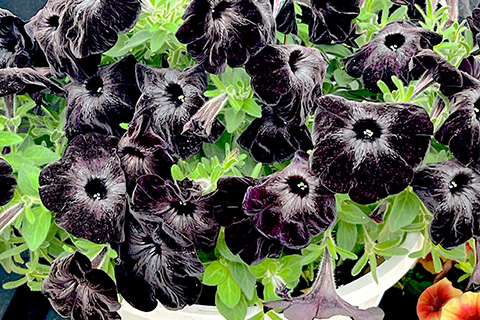 Petunia Fun House Black Widow (Syngenta)
Petunia Fun House Black Widow (Syngenta)
Black Widow is possibly the blackest black petunia we’ve seen. It’s new for 2026 in Syngenta’s Fun House collection of weird and wild petunia patterns.
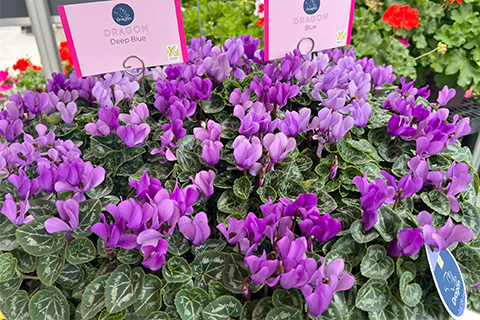 Cyclamen Dragon Blue, Deep Blue (Schoneveld)
Cyclamen Dragon Blue, Deep Blue (Schoneveld)
Schoneveld is best known for cyclamen (although they have much more than that), but they had just one new variety to show us this year ... but it is a breakthrough, and possibly one of the biggest we saw at CAST this year: It’s the world’s first BLUE cyclamen, which they named Dragon (in honor of its Japanese breeding roots). Now, admittedly, Schoneveld calls the two shades of blue “horticultural blue,” meaning it leans toward mauve or lavender. Still, Dragon is the closest thing we have to a true blue cyclamen. There are two shades, Blue and Deep Blue ... you can get them singly or as a mix. Dragon is a mini for up to 4-in. pots; we hope we’ll see the color in larger plant sizes.
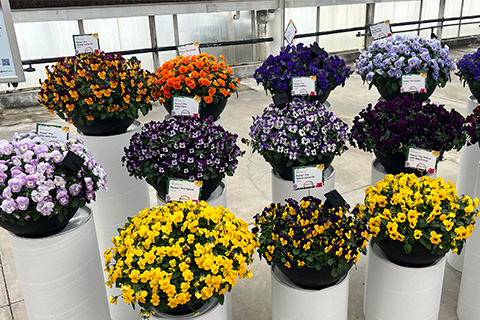 Viola Penny Pro Series (Syngenta)
Viola Penny Pro Series (Syngenta)
Forget what you know about the old Penny series because new Penny Pro Viola, like Delta Pro Pansy, is ready to meet the grower needs of 2026. It’s easy to grow and great for gardeners. Compared to Penny, it’s at least a week earlier, with an overall tighter habit and better branching. The series starts with 13 colors, plus some mixes. It’s gutsy to overhaul a mainstay like Penny, so we’re sure this is a true series upgrade.
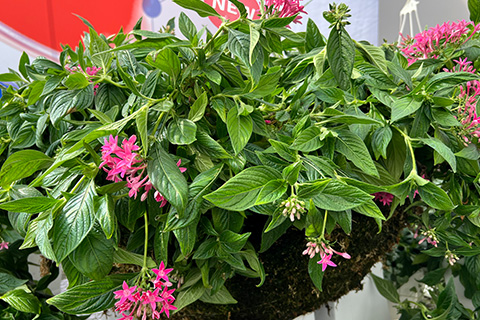 Pentas Graffiti Falls Rose (Benary)
Pentas Graffiti Falls Rose (Benary)
We were expecting new Graffiti Pentas, but were thrilled to see a whole new type: a trailing pentas called Graffiti Falls. And this thing really trails—as soon as the stem comes up it starts bending over. Growers will appreciate that it can be produced just like regular Graffiti Pentas, other than needing 10 to 14 additional days before it’s ready to ship. It starts with one color, Rose.
New Annuals Series
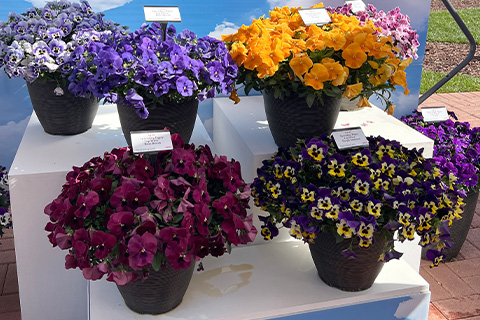 Pansy Top Wave (PanAmerican Seed)
Pansy Top Wave (PanAmerican Seed)
Top Wave joins Cool Wave in the Wave Pansy brand. Top Wave was bred to have flowers all over the top of the plant (Cool Wave is known to get a bit of a bald spot on top). Top Wave is also more of a grandiflora type, with 25% larger flowers than Cool Wave. But it’s still “easy spreading color” and great for spring and fall, like Cool Wave. The series starts with eight colors.
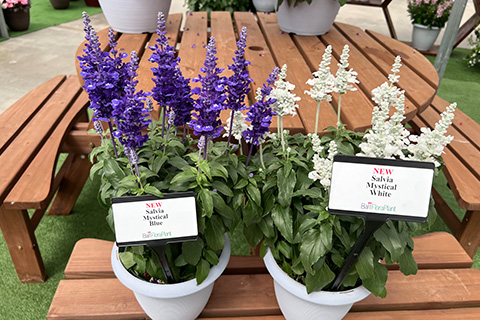 Salvia Mystical (Ball FloraPlant)
Salvia Mystical (Ball FloraPlant)
BFP has three lines of Salvia farinacea and S. farinacea crosses: the giant Mystic Spires, the mid-sized Mysty and now the compact Salvia Mystical—crisp and clean, with nice flowers held up on calyx that pick up the flower color. Mystical offers two colors: Blue and White.
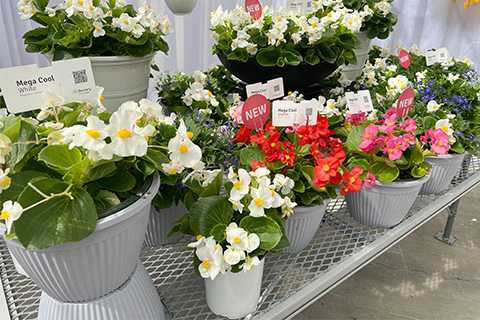
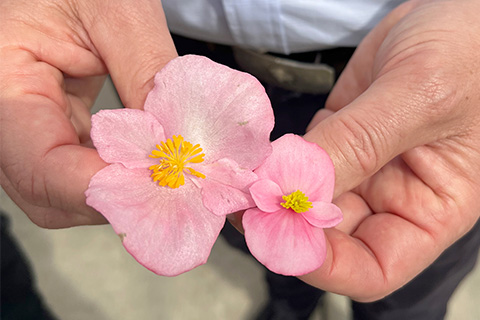 Begonia Mega Cool (Benary)
Begonia Mega Cool (Benary)
When we tell you its working name was Baby Big, you get the picture. Mega Cool is a B. semperflorens hybrid that’s only one-third the size of BIG, but with flowers just as big as BIG. Now, just because it’s smaller than BIG doesn’t mean you can shove it into packs; it still wants a nice pot. And their testing has shown it to be better in planters and combos than directly in beds. The series starts with four green-leafed colors (knowing Benary, bronze foliage can’t be far off).
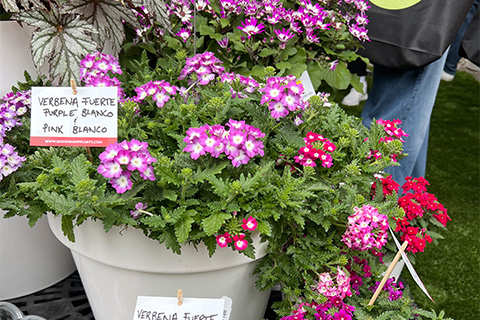 Verbena Fuerte (Beekenkamp)
Verbena Fuerte (Beekenkamp)
Beekenkamp has introduced their own breeding in the class with a series called Fuerte, which includes two distinct sizes/habits, both with strong powdery mildew resistance and weather tolerance—table stakes for verbenas these days. Denso is the more compact collection and includes three colors; while Blancos are semi-trailing and are available in eight colors.
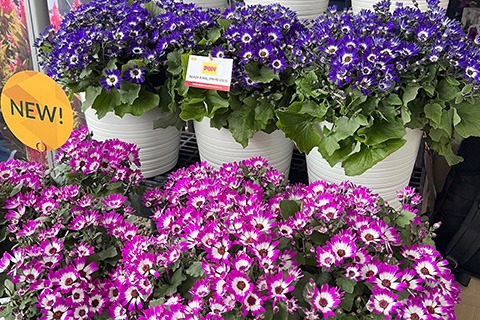 Pericallis Pop! (Beekenkamp)
Pericallis Pop! (Beekenkamp)
The Pop! series of pericallis (AKA cineraria) is from their own breeding and are selected for excellent rooting—upwards of 95% to 98% take, they say, which is excellent and opens the class up to more rooting stations and growers. They’re naturally compact and require no pinching. And they’ll hold up to a cold (55F/12C) growing regime, if you want to save money in winter when you’re producing them for early spring sales. The series has seven colors.
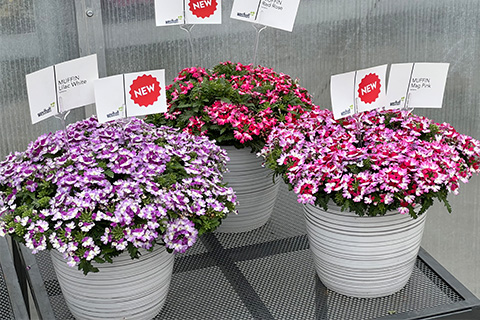 Verbena Peekaboo, Muffin (Westhoff)
Verbena Peekaboo, Muffin (Westhoff)
Peekaboo features a semi-upright habit and bright white eyes on all six colors (hence the name), while Muffin (pictured) is a compact little mounded muffin-top of a plant, needing no PGRs. It offers four colors.
 Snapdragon Sweet Duet (Syngenta)
Snapdragon Sweet Duet (Syngenta)
Sweet Duet offers huge double flowers on strong, well-branched plants that are great for the landscape or premium containers. The new series launches with five colors: Peach, Citrus, Deep Red, Deep Orange and Appleblossom. Tech tip: Alicain Carlsson told us the varieties are not photoperiodic, but crop timing is definitely impacted by temperature. Raise temps to 71F (21C) to cut a week and a half off production time compared to 62.5F (16C), as indicated by Syngenta’s research trials.
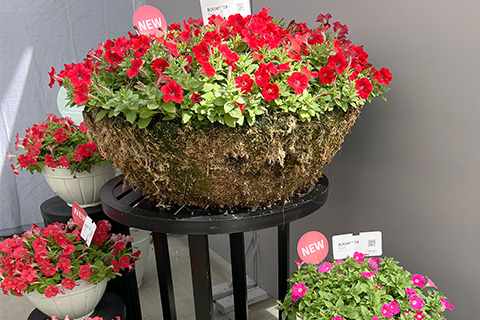 Petunia Boom! Trailing (Benary)
Petunia Boom! Trailing (Benary)
Prior to this year, Boom! hadn’t included a trailing version, but now there are five: Red, Rose, Coral, White and Blue. These aren’t pack types due to the trailing vigor, so grow them in bigger pots or baskets.
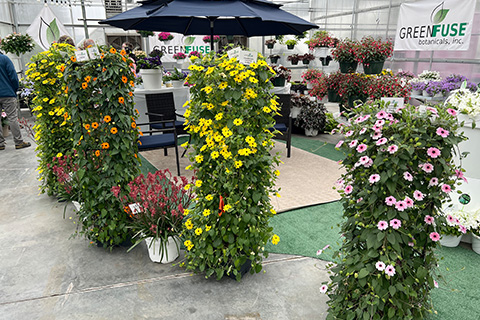 Thunbergia Uprising (Green Fuse)
Thunbergia Uprising (Green Fuse)
While existing thunbergia tend to be grown and sold by retail growers due to the plant’s size and vining habit (i.e. they’re difficult to ship), the new Uprising series is extremely responsive to PGRs and can be produced and shipped in gallons. The key is that they’ll grow out of the PGR effects in only three or four weeks—and then they take off and vine vigorously as expected. The series launches with six colors, including some really nice eyes and a pure white with eye.
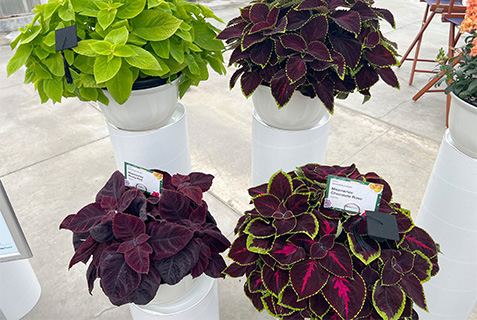 Coleus Mezmerize (Syngenta)
Coleus Mezmerize (Syngenta)
Syngenta launched their first seed coleus series—Mezmerize—with four colors. Chocolate Lime has dark foliage with green edges; Chocolate Rose has dark leaves with red veins down the middle and green edges; Rusty Red is just as it sounds; and, lastly, a clean Lime Green. They’re bred for late flowers and tidy habits.
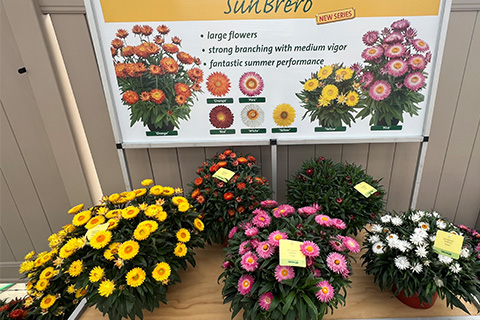 Bractheantha Sunbrero (Kientzler)
Bractheantha Sunbrero (Kientzler)
The newest strawflowers on the market are in Kientzler’s Sunbrero series, which are more compact than competitive genetics and launch with five colors: Orange, Pink, Red, White and Yellow.
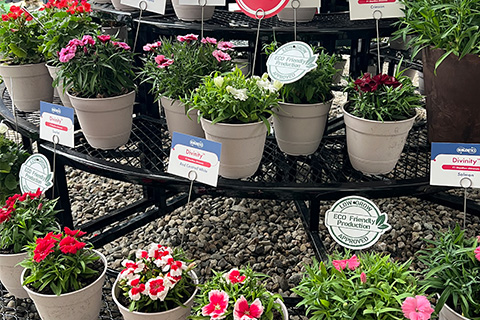 Dianthus Divinity (Hem Genetics)
Dianthus Divinity (Hem Genetics)
Divinity is a new D. chinensis series that has that no-PGR-needed compactness the Dutch breeder is known for. It’s like their Diana series, but more compact. Divinity offers seven colors.
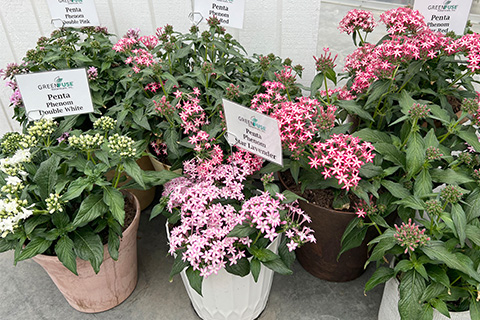 Pentas Phenom (Green Fuse)
Pentas Phenom (Green Fuse)
Phenom is from cuttings, not seed, so Green Fuse is concentrating on traits you can’t find in seed pentas—namely star patterns and double flowers. To that end, they introduced four new ones: Star Red and Star Lavender, and Double Pink and Double White. This is one we’ll need to test in the heat to see how it performs compared to existing varieties.
Other Notable New & A+ Additions
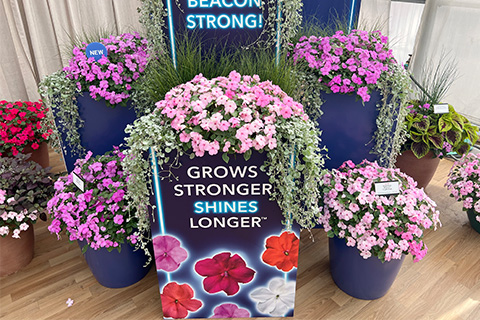 Impatiens Beacon Blue Pearl, Light Pink (PanAmerican Seed)
Impatiens Beacon Blue Pearl, Light Pink (PanAmerican Seed)
Newer, but certainly critical to the industry as a whole is Beacon—the impatiens with high resistance to impatiens downy mildew. When PanAm launched Beacon with a limited color range, we all knew they’d keep adding colors; now they’re up to 10, covering the range consumers and landscapers need. New for 2026 are Light Pink and Blue Pearl. PanAm also announced the charities supported through sales of Beacon: Extra Special People (providing opportunities for people with disabilities in the U.S.) and Green Fingers in the UK, which provides therapeutic gardens and experiences for children in hospice.
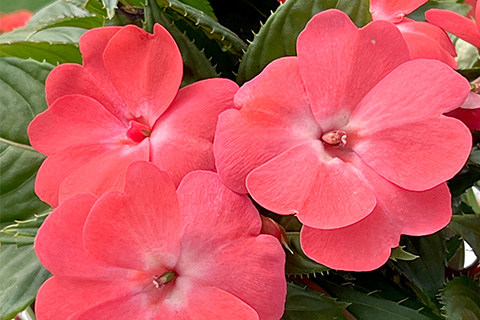 Impatiens Solarscape Salmon Punch, XL Brilliant Gems Mix (PanAmerican Seed)
Impatiens Solarscape Salmon Punch, XL Brilliant Gems Mix (PanAmerican Seed)
Solarscape is the first and only interspecific impatiens from seed. New in the standard-sized lineup is Salmon Punch (pictured); for the taller XL range is a mix called Brilliant Gems, which includes lilac, hot pink and blush shades for a pop of color in shady spaces. Tech tip: The experts at PanAm say you should grow Beacon on the dry side for best results.
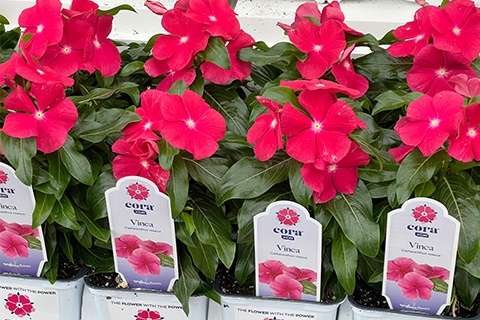 Vinca Cora XDR Red Glow (Syngenta)
Vinca Cora XDR Red Glow (Syngenta)
A series that dates back to the Goldsmith days is Cora Vinca, today known as Cora XDR for its continually updated aerial Phytophthora resistance (now up to 36 strains!). Cora XDR gets a striking Red Glow, which we judge is the redest red in red vinca.
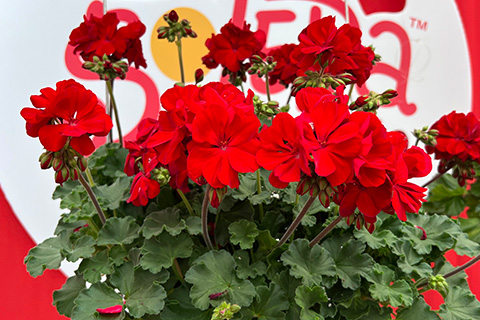 Geranium Solera Dark Red, Purple (Ball FloraPlant)
Geranium Solera Dark Red, Purple (Ball FloraPlant)
Solera Dark Red is an interspecific geranium meant to compete directly against the leader in interspecifics, Calliope. On the surface it looks good, with a deep red color, although to our eyes the foliage leans a bit more toward the ivy than the zonal geranium. Solera also gets Purple—a great color, but perhaps not as significant as Dark Red.
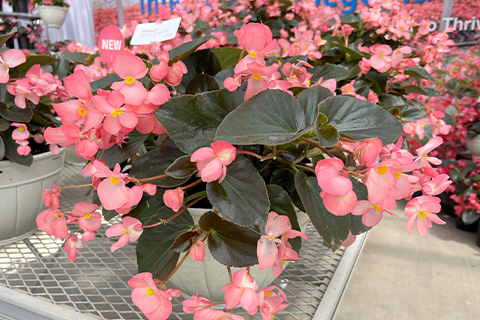 Begonia Whopper Salmon Bronze Leaf (Benary)
Begonia Whopper Salmon Bronze Leaf (Benary)
A Ball Seed-exclusive series that’s taller than BIG with fantastic landscape performance.
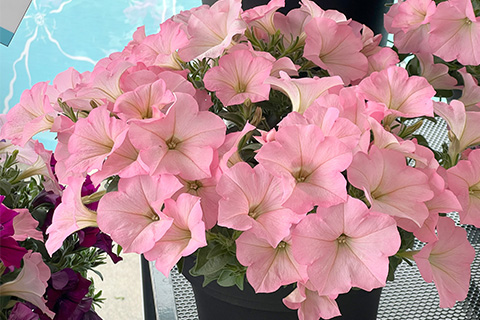 Petunia Surfinia Heavenly Cashmere Pink (Suntory)
Petunia Surfinia Heavenly Cashmere Pink (Suntory)
The Heavenly varieties were top sellers in the series, so breeding moved in that direction, and Cashmere Pink is a really nice, soft color with all of the attributes that make Surfinias favorites of growers and consumers.
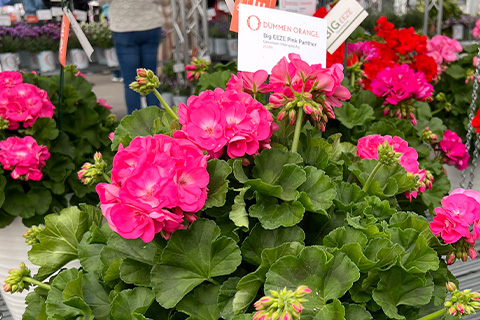 Geranium Big EZEE Pink Panther (Dümmen Orange)
Geranium Big EZEE Pink Panther (Dümmen Orange)
In the Big EZEE Interspecific Geranium series there’s a new one called Pink Panther. The color is a bit more neon than the famous cigarette-smoking cat’s fur. Big EZEE is known for having big flower umbels while being easy to grow.
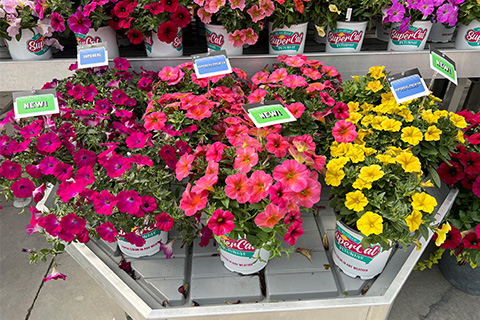 Petunia SuperCal Blue Eyed Rose, Coral Star (Sakata)
Petunia SuperCal Blue Eyed Rose, Coral Star (Sakata)
A cross between petunia and calibrachoa gives you durability, weather resistance (rain, cold and heat) and great colors you can’t find in regular petunias. There are two types in the SuperCal series: traditional (spreading) and premium (mounded). Premiums get two new colors: Coral Star and Yellow Sun Improved; while traditional gets Blue Eyed Rose.
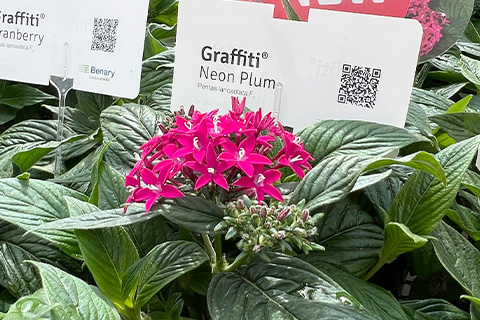 Pentas Graffiti Neon Plum, Deep Red (Benary)
Pentas Graffiti Neon Plum, Deep Red (Benary)
For 2026, Benary has added two new colors, Deep Red and Neon Plum (pictured), bringing the series to 17 colors and two mixes.
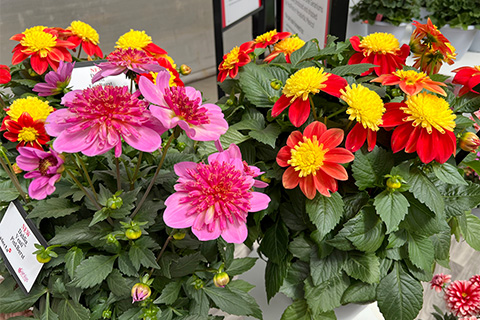 Dahlia Venti FireBurst, PinkBurst; Dalaya Red, Purple, Pink, Yellow (Selecta One)
Dahlia Venti FireBurst, PinkBurst; Dalaya Red, Purple, Pink, Yellow (Selecta One)
We may see nothing more colorful than the two new Venti Dahlias, FireBurst and PinkBurst (pictured). Ventis are Selecta’s biggest and most vigorous dahlias; these two are both anemone-flowered, so you get the ring of petals of a daisy with a big cushion in the center. FireBurst is vibrant, primary red and yellow, while PinkBurst has pink petals and a slightly deeper center. Also nice, if not quite as spectacular, are the five new colors in the mid-sized Dalaya collection: Pink Lace, Purple Lace, Red Lace, Yellow Lace and Cranberry. “Lace” indicates white tips to the flower petals.
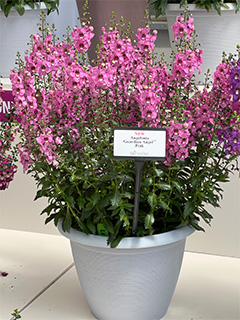 Angelonia Guardian Angel Pink; Archangel Fuchsia, Light Pink (Ball FloraPlant)
Angelonia Guardian Angel Pink; Archangel Fuchsia, Light Pink (Ball FloraPlant)
BFP has five angelonia series: Guardian Angel (extra-large), AngelDance (large), Archangel (medium), AngelFlare (medium V-shaped) and AngelMist (spreading). Knowing the habit helps with container selection, landscape or combo use and even performance by region. New for 2026 is Guardian Angel Pink (pictured), bringing the second-year series to three. Archangel adds Fuchsia and Light Pink.
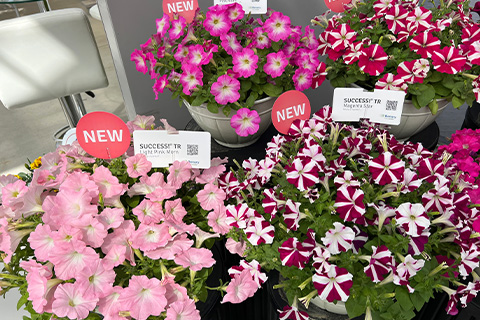 Petunia Success! (Benary)
Petunia Success! (Benary)
New for Success! grandiflora petunias HD types (high density, like for packs and bench-run production) is Rose Morn. For Success! TR, there are four new: Light Pink Morn, Magenta Star, Pink Morn and Rose Star. This is a prime example of how breeders are positioning products within series to help in plant selection for different uses and pot sizes.
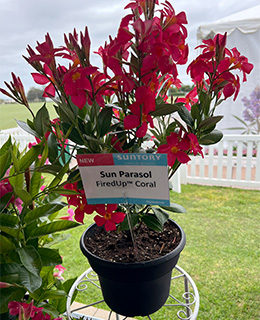 Dipladenia Sundenia Suprema Vivid Pink; Mandevilla Sun Parasol FiredUp Coral (Suntory)
Dipladenia Sundenia Suprema Vivid Pink; Mandevilla Sun Parasol FiredUp Coral (Suntory)
New varieties include Sundenia Suprema Vivid Pink, a big showy vining variety; Sun Parasol FiredUp Coral (pictured), an upright-growing, non-vining variety that joins FiredUp Orange; and Sun Parasol Original XP Pink, an upgrade from the original that’s brighter in color and earlier to flower.
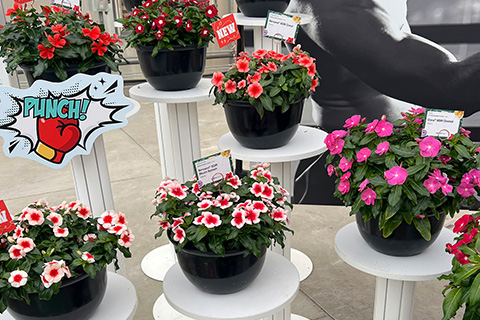 Vinca Nirvana Apricot Splash, Watermelon, Coral (Syngenta)
Vinca Nirvana Apricot Splash, Watermelon, Coral (Syngenta)
Nirvana XDR is the vegetative version of Cora XDR, offering unusual colors that can’t be achieved by seed (at least not yet). Nirvana gets Apricot Splash, Watermelon and Coral.
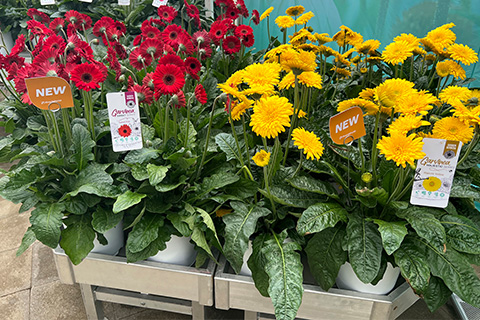 Gerbera Garvinea Sweet Chili, Majestic Yellow (HilverdaFlorist)
Gerbera Garvinea Sweet Chili, Majestic Yellow (HilverdaFlorist)
New for Majestic (double-flowered) is Yellow, while the Sweet series (single flowers) adds Sweet Chili.
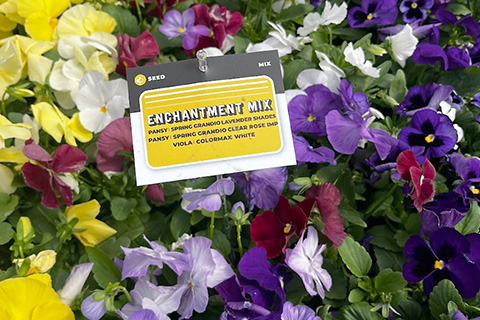 Pansy Spring Grandio Enchantment Mix (Sakata)
Pansy Spring Grandio Enchantment Mix (Sakata)
The Enchantment Mix features two Grandio Pansies and one ColorMax Viola—maybe the first time the two have been combined.
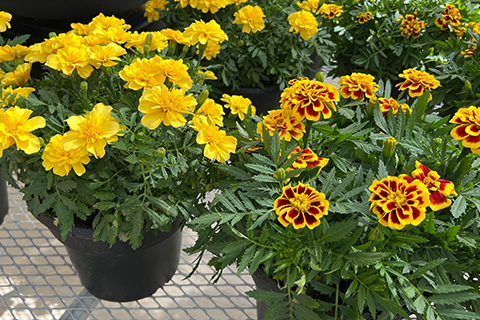 Marigold Mango Tango, Milli Vanilli (Benary)
Marigold Mango Tango, Milli Vanilli (Benary)
It was at our last stop of CAST when we finally spotted a couple of marigold introductions—a classic bedding plant we were all pleased to see! Both of these new standalones are tetraploids (resulting in strong, beefy plants) with interesting names. Mango Tango, an All-America Selections Winner, has red and orange anemone-shaped blooms, while Milli Vanilli fades dark yellow to light yellow with a more traditional bloom structure.
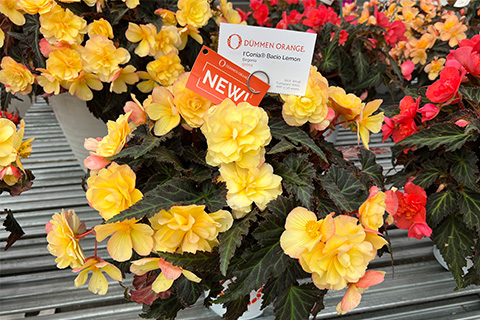 Begonia I’conia Bacio Lemon (Dümmen Orange)
Begonia I’conia Bacio Lemon (Dümmen Orange)
I’conia interspecific begonias are big, vigorous and colorful. New is I’conia Bacio Lemon. Bacio is the most compact of their three collections, but still with loads of flowers. Lemon is a peachy yellow, not a bright or pure yellow. It contrasts nicely against the dark green foliage.
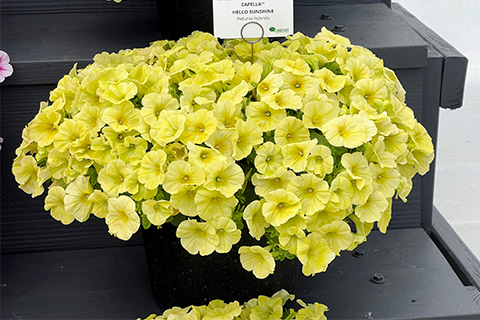 Petunia Capella Hello Sunshine, Berry Lace (Danziger)
Petunia Capella Hello Sunshine, Berry Lace (Danziger)
New to the Petunia Capella series for quarts (meaning they’re compact), but bred to gain size once they get to a consumer’s garden or patio, is Hello Sunshine (pictured), a bold yellow, and Berry Lace, which has vivid purple centers with nice veining. Both are striking.
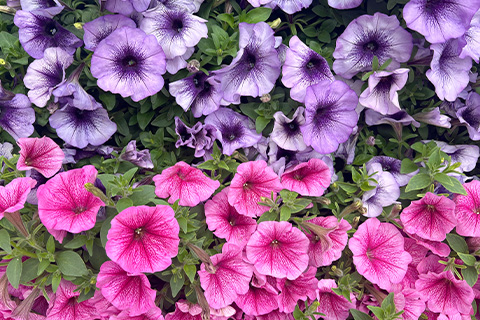 Petunia Trilogy Blue Vein, Rose Vein (Takii)
Petunia Trilogy Blue Vein, Rose Vein (Takii)
The Trilogy seed petunia series, named for its usefulness for 1) growers, 2) retailers and 3) gardeners and which competes with E3 Easy Wave, gets a pair of new colors: Blue Vein and Rose Vein. You can see the vein pattern in the photo.
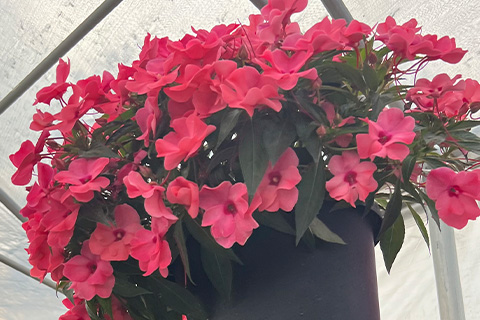 New Guinea Impatiens Harmony Colorfall Flamingo (Danziger)
New Guinea Impatiens Harmony Colorfall Flamingo (Danziger)
Selected for a unique hanging basket habit that results in foliage and flowers that sort of “bend” over the edge of the pot, catching attention when shoppers look UP at rows of baskets in garden centers. Usually all they’d see are stems and the undersides of leaves. That’s Lisa Heredia showing Colorfall’s best side.
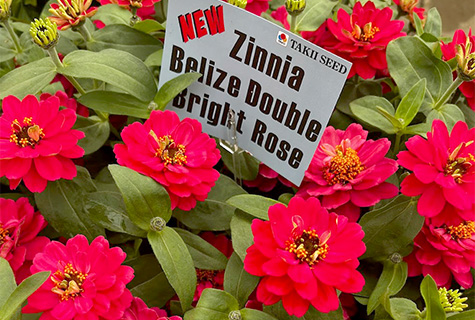 Zinnia Belize Double Bright Rose, Double Rose Bicolor (Takii)
Zinnia Belize Double Bright Rose, Double Rose Bicolor (Takii)
New in Takii’s Belize Zinnia assortment are three doubles—Bright Rose, Pink Bicolor and Gen 2 Rose (an improvement). This brings the series doubles up to eight and four single-flowered types.
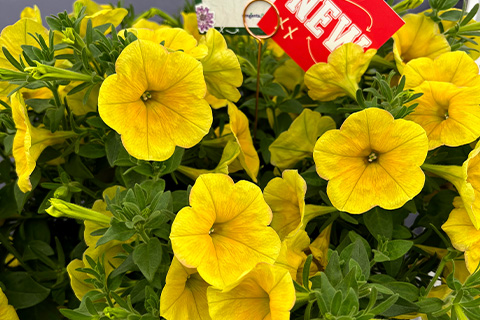 Petunia Sanguna Sunshine (Syngenta)
Petunia Sanguna Sunshine (Syngenta)
New in the Sanguna series is a strong yellow that will work very well in baskets and combos.
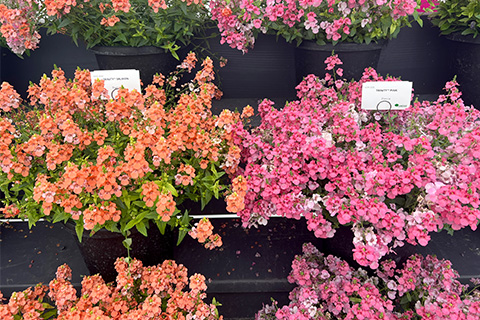 Diascia Trinity Salmon, Pink (Danziger)
Diascia Trinity Salmon, Pink (Danziger)
Remember when diascia were wild-looking, bloomed briefly and dropped spent blooms all over the place? Those days are long gone, thank goodness. Danziger’s series is Trinity and blends disease resistance, heat and weather tolerance, and shatter-free flowers. They add two colors for 2026—Salmon and Pink—making four total.
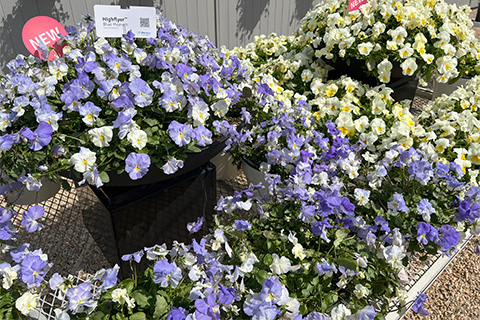 Pansy Highflyer (Benary)
Pansy Highflyer (Benary)
New in the Highflyer series of trailing pansies, introduced two years ago, are Violet Face, Blue Heaven and Lemon Splash (plus an improved Yellow Red Wing.)
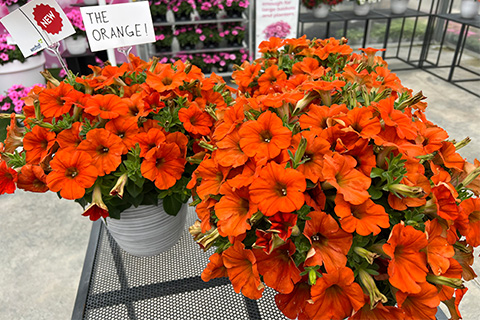 Petunia Inferno The Orange! (Westhoff)
Petunia Inferno The Orange! (Westhoff)
In name-change news, Westhoff had a collection of vivid red and orange petunias called Hells. Perhaps because that was a bit controversial, they’ve renamed that group Inferno. To Inferno they’ve added a unique Metallic Orange (with orange and magenta flowers) and another one called simply The Orange! Meaning, we assume, that it doesn’t get any more orange than that. It joins The Red!, introduced last year.
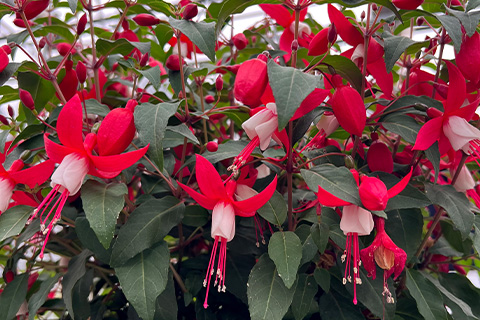 Fuchsia Windchimes (Green Fuse)
Fuchsia Windchimes (Green Fuse)
The Windchimes Basket collection gets two colors: Double Rose Violet and Red Vein. Double Rose Violet is the first large-flowered double for Green Fuse and it happens to carry the same color pattern as that venerable old variety Swingtime. And as Red (pictured) & White is their best seller, Windchimes Basket Red Vein should do well. The “vein” in the name indicates a red vein in the foliage. GT